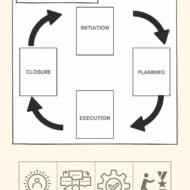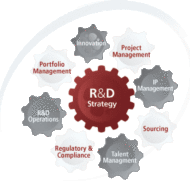Posted by Managementguru in Decision Making, Project Management, Strategy
on May 4th, 2014 | 0 comments

In many segments that rely on a culture of project management, the project officially begins with the official approval of the project, which is not so in the development sector, where the project life more commonly begins with a Project Identification and Screening Phase. The seed of a project arises merely as an idea – a need or opportunity that is weighed, scrutinized, and eventually developed into a project which is managed through the project life cycle. The most critical question one has to ask would be ‘Are we doing the right project?’ Because a problem well understood is half done. Let us Cruise Through the Ideas in Project Identification and Screening Search for New Ideas What are the objectives? *Brainstorm to generate alternative solutions. -Emerging market trends. –SWOT analysis. -Other constraints *Shortlist candidate ideas for detailed scrutiny. Motivation Projects are a means to accomplish -Individual or family objectives -Organizational objectives -National or global objectives Project Identification begins in response to the specific need or the objectives Objectives To increase profitsTo minimize threats of lossesTo become more competitiveTo provide help after a disasterTo train people in a new areaTo reduce pollution in DelhiTo become a successful entrepreneur Download this project planner template to effectively conduct your projects 👇 Minimal-and-Elegant-Project-Planner-TemplateDownload Swot Analysis A tool that detects the strengths, weaknesses, opportunities and threats of an organization. In particular, SWOT is a basic, straightforward model that measures what an organization can and cannot do as well as its probable opportunities and threats. The method of SWOT analysis is to take the information from an environmental analysis and distinguish it into internal (strengths and weaknesses) and external issues (opportunities and threats). Once this is over, SWOT analysis determines what may assist the firm in accomplishing its objectives, and what obstacles must be overcome or minimized to achieve desired results. • Objectives • Experience • Resources • Environment pressures -Keeping these factors in mind an analysis of strengths, weaknesses , opportunities and threats is made to identify and select suitable projects. STRENGTHS • Experience and expertise • Financial position • Capital raising capability • Industrial contacts • Foreign collaborations WEAKNESSES • Newer unfamiliar technologies • Inability to raise huge investments • Lack of experience • Lack of trained personnel • Inability to forecast market trends OPPORTUNITIES • Emerging technologies • New products with new markets • New processes with better features • Special financing schemes • Government and other incentives THREATS • Competitors • Poor state of the economy • Outdated technology • Unprofessional management skills • New products and services BRAINSTORMING • A good means to generate new project ideas • Focus on uninhibited participation by a group • Listing of ideas without suppressing creativity at source • List of ideas subjected to screening and evaluation subsequently Download this meeting notes planner template to effectively conduct your project meetings 👇 Pink-Yellow-Gradient-Project-Meeting-Notes-PlannerDownload SCREENING OF IDEAS Poor Fair Good Vgood Excellent (1) (2) (3) (4) (5) Weight •Cost * 20% •Risk * 30% •Return * 40% •Hazard * 10% •(score = 2×0.2+3×0.3+4×0.4+2×0.1= 3.1) CRITERIA IN SCREENING PROJECTS • Investment • Rate of return • Risk • Likely profit • Payback • Similarity to existing business • Expected life • Flexibility • Environment impact • Competition Let us look at the following example – Reducing Vehicular Pollution in Delhi Ideas Generated in Brain Storming Restrict registration of new vehiclesEnforce strict emission regulations for vehiclesBan diesel run vehicles on roadIntroduce MRTS – Mass Rapid Transport System for the cityEncourage use of car poolsGrow more trees/ green belts in the cityDeclaring no traffic zones in the cityBan vehicles with an age of ten or more years from plying on the roads These and...

Posted by Managementguru in Marketing, Principles of Management, Project Management, Strategy, Technology
on Mar 25th, 2014 | 0 comments

Research and Development – Strategic Key for Competitive Advantage Product Innovation and Process Improvement: With the increasing pace of liberalization and ferocity of competition in the corporate business world, it is mandatory for the firms to invest in research and development activities to sustain in the market. In most of the developing countries, scant attention has been paid to research and development activities. A survey indicates that countries like Japan and United States of America spend 2.8 percent of their Gross National Product on R and D, while it is a mere 0.9 percent of the Gross Domestic Product in the case of some Asian countries. What role does research & development play in the industry and economy? Why it is important for the developing countries to invest more on R and D? In spite of the tax rebate offered by most of the governments for R and D, why industries don’t contribute much to indigenous research? Global Competition: It becomes difficult for business organisations to compete in national and international markets both on quality and cost fronts, primarily because of absence of strong base in science and technology. Third world nations are used to buying technology from developed nations, that make them dependent and technology starved. Limited resource is another problem faced by these business firms, the allocation of which becomes difficult owing to rising costs. Invasion of Multinational and Trans national Giants: Another serious aspect to be considered is the invasion of multinational and transnational giants in every sector due to liberalization, globalization and privatization policies of the developing nations. This leads to panic in the industry, as a result of which, the business firms either go for forged alliances or infuse large amounts of funds into R and D activities hurriedly, both of which is a futile exercise to protect themselves from the onslaught of transnational companies. Science and Technological Advancement: The wiser move for the business firms to withstand the competition on an international level, would be to build their empires on a sustainable basis, by honoring the scientific and technological efforts. A thorough knowledge of all the research activities progressing around the world proves useful in managing their activities and operating with limited resources. This demands a long term plan that will support, strengthen and nurture the specified area of science base selected for research and development. Research Management: A well devised research management programme will help the business firms to formulate short and long term technical plans that aid in the research programme. It is very important for a country to encourage the budding population to become more research oriented, that will help the nation prosper in terms of science and technology, besides which, it also helps in the growth of one’s own economy. Chanakya’s 7 Secrets of Leadership The Research and Development strategic management lays emphasis on formulating plans, that support the short and long term objectives of a business firm, by employing innovative minds in the process and periodically reviewing and restructuring strategies in the light of changing demands of the society. The focus of an R and D manager should be on appraisal of technological and competitive environment, assessment of corporate strengths and weaknesses and making strategic decisions, while formulating R and D...

Posted by Managementguru in Project Management
on Mar 6th, 2014 | 0 comments

A project can be made into a roaring success provided you have made your in-depth analysis and research to understand the nuances of the industry. Running a restaurant though looks cheesy from outside needs meticulous planning. Before plunging into the market it is better to have the data ready with you. How prepared you are to run the business is not the question; how well prepared are you to face the hurdles and challenges that come your way is all that matters. Only if you withstand the rough weather may you proceed to grow and then expand. Industry Insights Restaurant industry is one such area where many people try to set their foot daydreaming of immediate success. Unfortunately the scenario doesn’t warrant instant success. Any business that has a slow and steady growth makes it to the top. Have you ever thought about the wherewithal needed to run the show! The industry looks very appealing and promising from outside but reality matters. The industry’s main focus is on supply chain management where your primary and ultimate focus revolves round your customers, who are your main focal point. Info Courtesy: AycockMarketing Value Added Services Customer satisfaction should be your vision, mission, objective and goal. Of course you want to make profit. For what else in the world have you entered this business. But think about it, if you are not able to attract crowds, the effort is wasted. The qualityThe varietyThe appealThe presentationThe treatmentThe ambienceThe refreshment, that is being offered to the customers should make them feel special and worth the value of money they are shelling out to have an evening out with their family or friends. Rising costs make people think twice before they decide on their choice of restaurant. Be sure about the class of people whom you want to cater the needs. Go for the plan accordingly and design your restaurant. Is Your Design Appealing? The design includes a sober atmosphere where the visitors can relax, mild lighting that is soothing to the eyes, mellifluous music that creates a magical effect and the choice of drapes and furnishings that add grandeur. The core concept of food industry is “customer satisfaction“. A company’s greatest strength is the quality of its professional management. You have to manage your human resource personnel, the waiters, waitresses, the chefs, the managers, billing clerks in such a way that their one and only motive is to give quick service and great service the first time and every time. Managing Your Financials Managing your financials is an absolute necessity. The initial investment has to be taken care of since you do not know the period it takes to establish yourself in the industry. How, big chain of restaurants is run successfully all over the world? First four or five years are particularly important to prove your credibility both to yourself and others. They do their complete market research wherein the customers’ preferences are jotted down and taken into consideration. High performing and high potential managers are put into place to run the show without a hitch. Well trained waiters are a big plus. Big companies diversify to invest their profits in ever prosperous areas like food industry, where people are constantly looking for new arrivals and the “brand image” that the big companies establish cannot be matched by small time players. Great service is the key factor that makes these big time players unique. Locational Advantage Locational advantage is the most important criterion for a restaurant industry. Sufficient space must be provided for parking and the access to the location be made a pleasurable experience. Don’t go for guidance from your local competitors or friends,...






